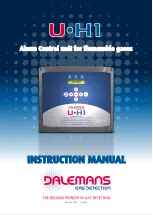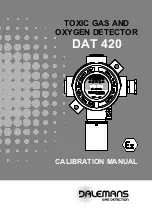
Installation, Operation & Maintenance Manual Merlin Detector i-S
Iss: 1 170322
10
Why is it important?
A detector may visually appear in good working order, but its sensitivity and accuracy can be inhibited by external
factors. Dust, humidity, temperature fluctuations, cleaning products, contaminants, exposure to its target gas or
sensor drift (ageing) can cause a decline in sensitivity, accuracy, and eventual failure.
How often?
Regular bump tests are important to make sure the detector can detect a release of gas as early as possible and
usually takes seconds (gas type dependant i.e., CO sensors will take over a minute) and is often completed alongside
a scheduled fire alarm test, however the frequency should be determined following an appropriate risk assessment by
the end user. We recommend testing detectors every 12-18 months along with the regular fire test procedures and
coincide with the annual service message prompted on the detection system after each year of service/operation.
What do I need?
Contact your S&S representative for details of suitable bump testing kits and gases. Kits usually consist of a certified
gas cylinder or spray. We recommend only using S&S calibration gas kits to ensure correct flow rates meet S&S
technical requirements. A bump testing gas is usually a concentration mix that exceeds the highest alarm set point.
Bump Test Procedure
To increase reaction time, cover the escape vents at the sides of the device.
Always remove the regulator/valve if using a cylinder after use!
Always give at least five (5) minutes between testing the same unit or until gas has fully dispersed!
Always consider safety and use equipment in accordance with Safety Data Sheets!
Reference should always be given to any applicable national & local law and industry codes.
Generally, the gas concentration should be greater than the alarm threshold of the device.
Always remove the regulator/valve after use if using a cylinder!
All cylinders will re-seal upon removal of the regulator/valve!
Deviating from this test process is deemed improper and may affect the functional safety of your device!
Exposure to chemicals, smoke, or any other materials other than the gases intended to be monitored can seriously damage
the gas sensing elements!
Always allow a minimum of 5 minutes before testing the same unit!
1.
Ensure you have the correct gas for the device type prior to application.
2.
Offer up the applicator hose/cone or spray and apply to the small vents of the device located underneath.
3.
Apply gas.
4.
The device will enter alarm status after reaching alarm set point.
5.
The device will activate all configured outputs/relays.
At this point…
6.
Remove applicator hose/ cone or spray.
7.
Reset by pressing the touch sensor.
8.
Test complete.
9.
Record your test details.
End of Operational Life (EOL)
The EOL is approximate from the first five (5) hours of continuous power!
The EOL will depend on the type of gas your detector is targeting and may vary depending on its application and
environmental conditions such as the frequency of exposure to the target gas, poisons, or inhibitors!
The typical life of a gas detector depends on its application and intended target gas, in addition the
operational life can be prolonged if the system and equipment is installed and maintained in accordance
the instructions stated within this manual. At the end of its predicted operational life
–
the detector will display an ‘End
of Life’ screen.
This message indicates that the detector has reached its expected operational lifecycle and no gas
levels are displayed. You must contact your supplier immediately for replacement.






























